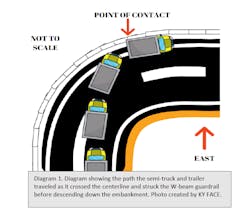Fatality Investigation: Truck Driver Dies on Two-Lane Highway
The Kentucky Fatality Assessment and Control Evaluation (FACE) Program is tasked with investigating fatalities and making recommendations to ensure they do not occur again. This is one of their recent cases.
On Monday, Sept. 30, 2019, a commercial truck driver was involved in a fatal single-vehicle collision while traveling eastbound on a state-maintained, two-lane highway.
The driver, a 68-year-old, married high school graduate, was operating a 2003 Freightliner Cascadia semi-truck and trailer eastbound on a two-lane Kentucky state highway. He was en route to a Kentucky-based business to deliver a load of farm tractor parts.
Because the victim was self-employed, little is known about his employment background.
According to the investigating officers, at 6:05 a.m., the driver entered a right-hand curve traveling approximately 55 miles per hour, while ascending a hill with a grade of approximately 18 degrees. Investigators determined the speed of the truck was too fast for the type of terrain the semi-truck and trailer was traveling, which resulted in the driver losing control of the vehicle. The driver attempted to regain control of the truck by taking evasive action, but was unable to do so before crossing the centerline and entering the westbound travel lanes. The trailer struck the W-beam guardrail that separates the west-bound travel lane from a large embankment.
The force of the impact punctured and compromised the guardrail, and the shifting weight of the cargo pitched the trailer off of the roadway. The trailer overturned as it descended down the embankment, subsequently pulling the tractor down and overturning it as it exited the highway down the embankment.
The semi-truck came to final rest partially on the west-bound travel lane with the rear of the truck and trailer completely off of the roadway. First responders arrived on the scene of the crash at 6:37 AM. Upon approaching the vehicle, it was determined that the driver had succumbed to injuries sustained in the crash, and he was pronounced dead at the scene. Accident investigators determined the victim was wearing a seat belt.
According to the death certificate, the victim died due to positional asphyxia and blunt force injuries as a result of a motor vehicle crash.
Occupational injuries and fatalities are often the result of one or more contributing factors or key events in a larger sequence of events that ultimately result in the injury or fatality. NIOSH investigators identified the following unrecognized hazards as key contributing factors in this incident:
- Traveling too fast for terrain
- Failing to inspect equipment
- Operating equipment with inadequate brakes
RECOMMENDATIONS
Recommendation #1: Commercial motor vehicle (operators should adjust speed to safely match adverse terrain conditions.
Collision investigators determined that the driver was traveling at a speed inappropriate for the type of terrain and vehicle being operated. It was determined that the truck was traveling at or near the posted speed limit of 55 miles per hour; however, this section of highway is particularly curvy with several large ascending hills. Due to the treacherous nature of the highway, investigators stated that the vehicle was traveling at a speed that was too fast for the terrain.
Recommendation #2: CMV Operators should complete driver vehicle inspection reports on all equipment prior to operating commercial vehicles.
Collision investigators determined that multiple brakes were out of adjustment on the semi-truck and trailer combination. In addition to traveling too fast for the terrain, having inadequate brakes may have led to the driver being unable to slow the vehicle effectively. Examining all vehicle components is a critical step in ensuring the safe operation and mechanical road worthiness of a commercial motor vehicle. It is unknown whether or not the driver completed a vehicle inspection; however, had a proper vehicle inspection been completed, the brake violations may have been discovered and allowed the operator to perform proper repairs on the equipment.
Recommendation #3: The Kentucky Transportation Cabinet should consider assigning commercial vehicle specific speed limits to state highways.
Collision investigators determined that the involved semi-truck and trailer was traveling at approximately the posted speed limit of 55 miles per hour. However, investigators also determined the speed traveled was too fast for the type of terrain and vehicle being operated. Speed limits are typically set to apply to passenger vehicles and do not account for the added size and weight of commercial motor vehicles. CMV’s can legally weigh up to 80,000 pounds and reach lengths up to 65 feet. Due to the extended weight and length, commercial vehicles struggle to navigate rural state highways as easily as passenger vehicles. Currently, commercial vehicles are held to the same standard as passenger vehicles on most state-maintained highways.
About the Author
DeAnna McIntosh
Safety Specialist
DeAnna McIntosh currently serves as the safety specialist for the Kentucky Fatality Assessment & Control Evaluation (FACE) Program within KIPRC. With a focus on prevention, her reports analyze a variety of contributing factors to each case, and subsequently make prevention recommendations centered on administrative controls, environmental controls, PPE use and existing safety regulations.


